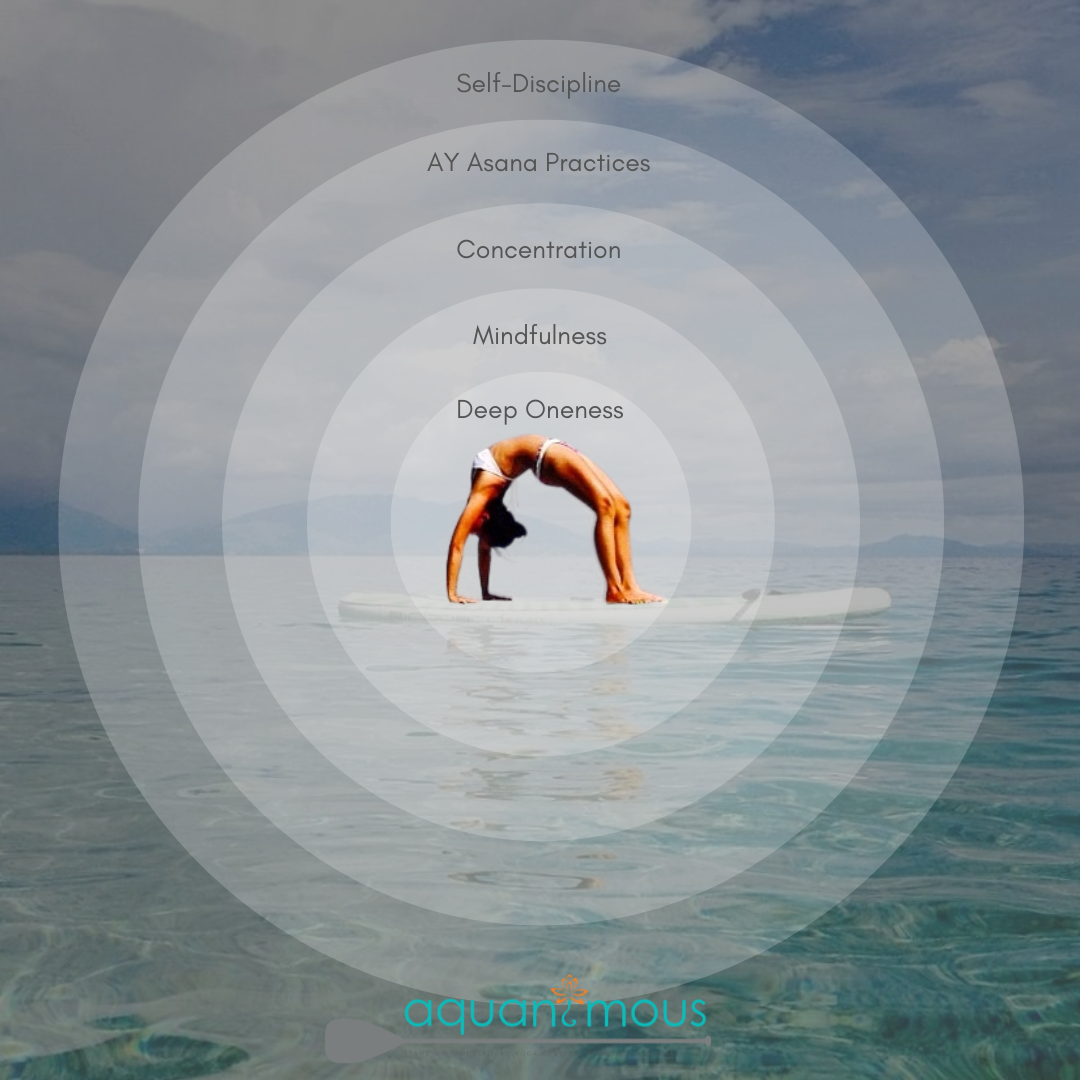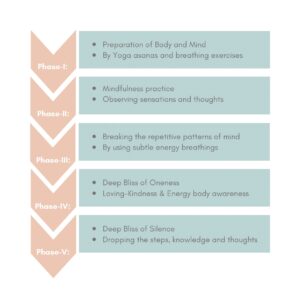
22 Aug The Structure of the AY Practice
THE FIVE MAIN COMPONENTS OF AN AY PRACTICE
-
- Self-discipline
- AY asana practices
- Concentration
- Mindfulness
- Deep feelings of Oneness
Self-discipline, AY asana practices and concentration are at the foundation of the structure. But mindfulness and the feeling of deep oneness are at the core.
FOUNDATION OF THE AY PRACTICE
‘Sila’, ‘Samadhi’ and ‘Panna’ are the three pillars of vipassana meditation. Almost the same things are known as Yama, Niyama and Samadhi in Patanjali’s yoga. The meanings of these three are self-discipline, concentration, and wisdom. The last two features are developed by meditation practices. However, these in turn depends on the foundation of self-discipline. In yoga, “Yama” and “Niyama” are two cornerstones, on which the entire gamut of yoga practice depends.
If we do not have some degree of self-control in our actions and deeds, the mind cannot concentrate and meditate effectively. However, by practicing some regulations on our behavior, meditation practice will move forward effortlessly.
Respect, responsibility, kindness, honesty, and trust towards higher value are the foundations of character. Character gives integrity. Integrity gives internal consistency. It gives the stability of mind. It frees the mind from inner conflicts. When our mind is free from inner conflicts, we can achieve the highest.
FIVE PHASES OF THE AY PRACTICE
The AY Practice is a deeply personal journey of discovery. The main component of this integrated journey is deep sensation awareness with yoga asanas and subtle breathing exercises. The various phases of the AY Practice include development of deep awareness, concentration, loving-kindness and the feelings of deep oneness.
Broadly speaking, the AY Practice can be classified into five phases. The intensity of these phases varies as we progress forward. In the initial phases, emphasis is given on body movement, and at the later stages much emphasis are given on deep meditation.
However, the practices are not in sequential fashion. There is much overlapping in between the phases. These phases are not done in a rigid fashion.
For example, the practices discussed in phase 1 will decrease in its intensity as one advance to other phases. In the beginning, the emphasis will be more on yoga asanas and body movements. This will be refined and more emphasis will be given on development of faculties like tranquility and equanimity in the subsequent phases.
Moreover, the phases are not linear. It works in a spiral way, so that we can experience the state of Samadhi on a regular basis. The busy mind will get a chance to touch its base as the silent unified field of consciousness.
The five phases are as follows:

Phase-I: Preparation of Body and Mind
This includes dynamic and static asana practices, subtle breathing exercises, breathing awareness and concentration practices. In the sections below we will discuss more about these practices.
Phase-II: Vipassana and Mindfulness
This phase includes mainly body posture awareness, sensation awareness and thought awareness. We will discuss more about these mindfulness techniques in the Somatics chapter of this guidebook and in the Aqua Sati Meditation Course Guidebook.
Phase-III: Breaking Repetitive Thought Patterns
This involves very subtle breathing exercises known as Suksma Pranayama. Generally, based on the condition of the body and mind, the student or the AY Teacher decides which subtle breathing technique will be most suitable to follow for a specific session. These includes the practices like “Apana” and “Prana” balancing, subtle spinal air balancing, left brain and right brain balancing, balancing of the two lungs, etc.
The objective is to stay in a calm and tranquil state by cleaning repetitive thought patterns. These are very minute breathing exercises, without disturbing the peaceful mental state. They are done in an almost effortless manner. We breathe through the whole body, and not just through the noses or with the help of the organs such as the lungs, chest or diaphragm. These subtle energy breathing techniques are designed to bring the whole mind and body in balance. They are done by balancing the left with the right, top with the bottom, front with the back without mental effort, but with the natural flow of awareness and breaths.
There are eleven base centers or spots in the body which are associated with this subtle breathing technique. The base centers are as follows:
-
-
- Tip of the nose
- Middle of the forehead
- Middle of the top of the head
- Middle of the brain
- Palate
- Base of the throat
- Breastbone (the tip of the sternum)
- Point just above the navel
- Point just below the navel
- Toe of the left foot
- Toe of the right foot
-
Subtle breathing is done by focusing at any of these points and then by distributing the awareness throughout the body. One can take the help of their teacher or can explore and discover the point, ratio or pathway that fits them. If you have headaches or nervous problems, don’t focus on any spot above the throat.
Phase-IV: Deep Bliss of Oneness
The entire body is in a flux. When we deeply observe our body parts, inner and outer organs, wisdom and insights arise within, and we are able to dissolve our wrong indentification with the body.
Similarly, when we can deeply observe our thoughts, we can remove our wrong identifications with the thoughts. When we are free from the wrong identification with the body and mind, we will realize the bliss of oneness. When we realize the bliss of oneness, then, loving-kindness, compassion, sympathetic joy, and non-attachment will arise spontaneously. They are the fruits of the AY Practice.
When we realize that oneness, our ego dissolves. Our struggles, competition, unnecessary survival instincts, unwanted fight or flight response dissolves. The deep realization that we are part of the eternal existence arises. We are not an isolated independent being. There is nothing to be owned as our own. We are part of universal consciousness. This feeling arises not as an intellectual understanding but as a deep subjective conviction.
In this context, it should be noted that the chakra purification meditation deeply facilitates this feeling of oneness. The blockages in the chakras (energy centers) occur due to restrictions in our thoughts and movements.
When we do aware chakra meditation, our system gets purified and blockages to happiness are released. The combination of the chakra purification meditation and insight practices provides this intrinsic happiness, which is our true birthright and spiritual reality.
This uncovering of bliss consciousness is the specialty of
yoga. Yoga teaches us to pay deep respect towards this Divine energy that manifest as the Life Force in all beings. This respect helps us to understand that true nature of the world. From that understanding, we get liberation; liberation from the past impressions. One can feel the connection to this life energy by sending positive thoughts, love and compassion to every animal, tree, plants and human beings. This is what yoga ultimately is: Union. Union with existence by expanding our love and compassion in every direction.
Phase-V: Deep Bliss of Silence
Silence arises out of profound inner and outer harmony. An unenlightened mind is always filled with ideas, opinions, words, questions, desires, doubts, suppression, conflicts and manipulations. An enlightened mind is always calm and poised. An unenlightened mind has a lot to say, but an enlightened mind is free from thoughts. For an enlightened mind, there is hardly anything to say; it has only to radiate bliss, tranquility, calmness, serenity, and silence. This radiating joy is a hallmark of an enlightened personality.
Pure silence arising out of deep bliss is not really an object of meditation. It is one of the highest transcendental states of mind. Normally, during meditation, there are various types of disturbances and noises. Noises may be internal or external. There are gross noises and subtle noises. It is easy to isolate the gross noises but it is difficult to isolate the subtle mental noises. The noises like ideas, opinions or judgments are subtle mental noises. When these waves settle down, real silence arises.
However, to reach the pure silence we need to drop all the steps of meditation. The real meditation begins when we drop all the steps of meditation. The real meditation begins when we drop all the teachings, all the dhammas, all the ideas, all the opinions and all the acquired knowledge.
Everything is happening in the background of silence.
Silence has to be realized in the midst of noise because in the background of disturbance, there is an abode of deep blissful silence. This silence is the universal screen or background for the whole existence to play on it. It is cosmic, and it is independent of time and space.
As the water exists in the wave and wave in the water, similarly silence exists in the noise and noise exists in the
silence. When we notice the silence in the sound of the breath, silence in the sound of the wind, silence in the waves of the ocean, silence in the sound of the leaves, silence in the song of the birds, we are in the dimensions of divinity. Through noise, divinity is inviting us to the world of silence. Silence is the medium to realize the truth. Silence has enormous transforming power. Most people are unaware of this inherent source of this blessedness that exists at the core of their being. Deep meditation wakes up this dormant faculty and brings us closer to that infinite purity.
To progressively attain this deep bliss of silence, there are two steps. The first step is contemplating the blissful nature of the deep silence. The second step is the step of dropping the steps. It is the step of complete let go. Feel the deep silence somewhere in the heart. Feel the deep silence throughout your inner being. Finally, let go of the dropper, let go of the feeler, let go of the meditator, let go of the mind and just abide in the eternal suchness. Initially it comes and goes in a discrete pattern. As our practice ripens, the deeper and continuous blissfulness of silence arises spontaneously.
FOURFOLD TRAINING IN AY
The five main components of an AY Practice are categorized into four (4) training components:

DEVELOPMENT OF SAMADHI: THE GOAL
Samadhi is always in the forefront of the AY Practice. It is the guiding force behind all other steps. Initially, it may be gross Samadhi but as we progress, the experience of Samadhi will be subtle. Samadhi starts the moment we are with ourselves. The deeper we are with ourselves the deeper will be the degree of Samadhi.
Our thoughts are not allowing us to be fully present with ourselves. Sensation awareness and breathing awareness are the means to reach to our inner being. Our thoughts consume most of our brain energy. When we are 100% with our inner being, our brain energy is optimally used and we get maximum satisfaction and we become in touch with collective consciousness. Samadhi is the perfect state of human body and mind, where one can experience deep blissfulness, vastness of consciousness and deep silence together.
Samadhi is the journey from individual to collective consciousness. The steps of Samadhi are the steps towards reaching the collective consciousness. In meditation, the more we radiate love, compassion, peace, harmony and tranquility, the more is our contribution towards the collective consciousness. The more we positively contribute towards the collective consciousness the more is our progress in Samadhi.


No Comments